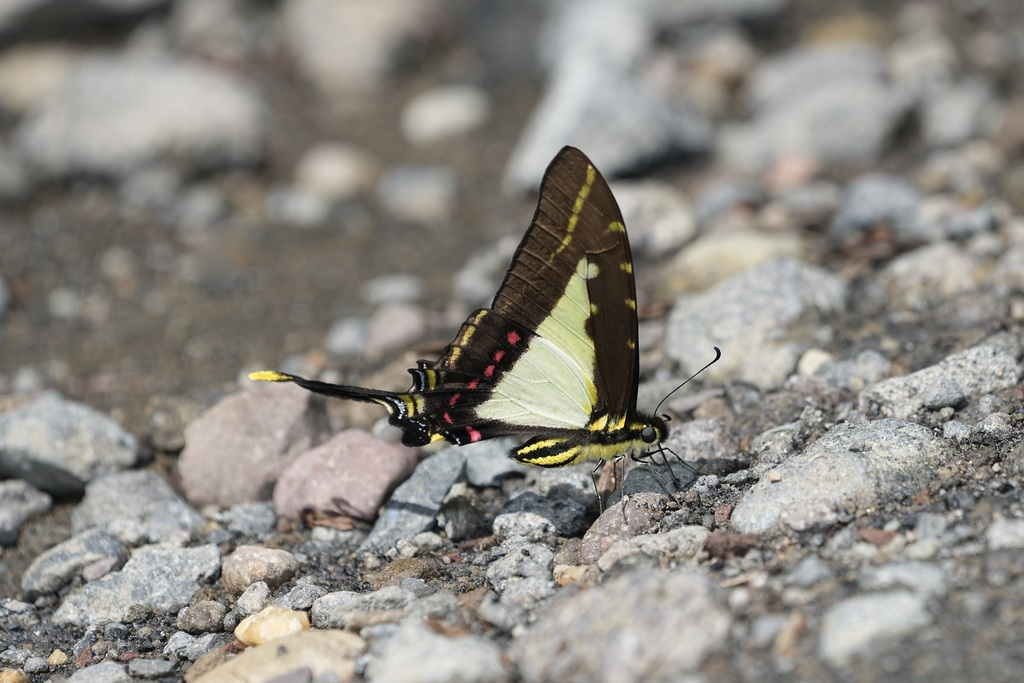Eurytides (or Protographium) leucaspis is a large Kite Swallowtail found in Colombia, Ecuador, Peru, and Venezuela.
Photo by Lesly Espinoza.
Leucaspis means "white shield." The butterfly does not have a shield, or shield-shaped marking; if its central triangle or trapezoid were seen as a shield, it would still be green, yellow, or pale brown more often than white. Swallowtail species names were traditionally chosen in honor of heroes of literature. Leucaspis was a young war chief who challenged Hercules to fight. He lost, of course, because according to the story Hercules was the strongest man alive in his time. Leucaspis was considered heroic for daring to try.
Leucaspis, the butterfly, fades dramatically.
These eye-catching Kites, with wingspans normally just under four inches and some of the longest "swallow tails" in South America, are poorly documented--usually by photographs of individuals at puddles:
It is divided into two subspecies, E. or P. leucaspis leucaspis and E. or P. leucaspis lamidis (some sources show lamis), with just noticeably different arrangements of spots on the undersides of the wings. The forewings of lamidis may be "falcate"; those of leucaspis are more nearly straight-edged. These distinctions are not always obvious to non-specialists. Bodies are furry, sable above with yellow or tan stripes on the sides. Males' hind wings have scent folds in which the scales are modified into surprisingly long hairs.
For Kites these butterflies are gregarious. Male Swallowtails emerge from their chrysalides hours or days before they are ready to mate, and spend some time hanging out at puddles, sipping water that contains mineral salts. Some species favor clean water that absorbs a few minerals from the sand below. Some positively prefer polluted water. Female Swallowtails are pollinators; in many species males are composters. (Females usually get their mineral salts by contact with males.) Some Swallowtails form huge flocks at puddles. Kites, being monophagous, often look for large amounts of interpersonal distance and try to be the only Kite of their gender and species in a neighborhood. Leucaspis apparently does not share this craving for space.
Photo by Andreas Kay. Feasting on an oil-slicked puddle, these four butterflies crowd together so closely that their wings touch. In another photo, two more join them.
Female Swallowtails, who are usually ready to mate by the time they can fly, visit the puddles and often find mates there. After mating they spend most of their time looking for suitable places to lay their eggs, and are harder for humans to photograph or "collect" at puddles. Most photos of leucaspis online come from museums, and are of males collected at puddles.
The Kites, however, have tended to be poorly documented. (The Zebra Swallowtail is an exception. North America adores the exotic look of its one resident Kite species. Zebras have been heavily documented.) Though Naranjo and Restrepo rated leucaspis third on a list of butterflies that seemed interesting enough to be made "focal species" for the conservation message, leucaspis rated 28 points where two other Swallowtails (even bigger and showier) rated 30. As a result, Rothschild wrote more than a hundred years ago that the early life, even the female, of this species was unknown, and not much has been added to the world's knowledge since then.






No comments:
Post a Comment